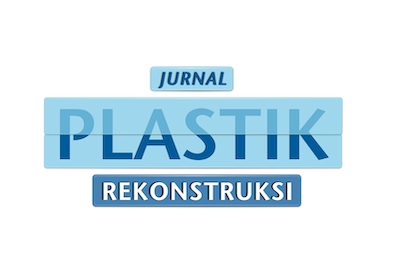The Outcome of Keystone Flap for Lower Extremity Defects: A Systematic Review
DOI:
https://doi.org/10.14228/phnjj003Keywords:
Keystone flap, Lower extremity defect, Reconstructive surgery, Soft tissue repair, ComplicationsAbstract
Introduction : Lower extremity defect poses a significant challenge in reconstructive surgery due to the limited usability of soft tissue. The keystone flap which utilizes fasciocutaneous perforators, has emerged to be a potential technique in fixing soft tissue defects. However, scientific evidence, specifically on its effectivity and complication rate in lower extremity defect is lacking. Therefore, this systematic review aims to assess the outcome and potential complications correlated to the use of Keystone Flap in repairing lower extremity defect.
Method : This systematic review was done in accordance to the Preferred Reporting Items for Systematic Review and Meta-Analysis (PRISMA). Literature searching was conducted using four databases, which is PubMed Central, Embase, Scopus and Cochrane Library.
Result : A grand total of sixteen studies were included in the review. Among it, fourteen studies were case series. The others were cohort prospective and single arm interventional studies. Out of the 662 keystone flaps used, a total of 129 complications (19.5%,) were recorded, with the majority being infection or cellulitis (5%, n=33), delayed healing (4.5%, n=30), wound dehiscence (4.3%, n=28), and partial flap loss or necrosis (2%, n=13).
Conclusion: The keystone flap could be an alternative for lower extremity defect with a realtively low complication rate.
References
1. Soltanian H, Garcia RM, Hollenbeck ST. Current concepts in lower extremity reconstruction. Plast Reconstr Surg. 2015 Dec;136(6):815e-829e. https://doi.org/10.1097/PRS.0000000000001807.
2. Hallock G. A paradigm shift in flap selection protocols for zones of the lower extremity using perforator flaps. J Reconstr Microsurg. 2013 Mar;29(04):233–40. https://doi.org/10.1055/s-0032-1328919.
3. AlMugaren FM, Pak CJ, Suh HP, Hong JP. Best local flaps for lower extremity reconstruction. Plast Reconstr Surg - Glob Open. 2020 Apr;8(4):e2774. https://doi.org/10.1097/GOX.0000000000002774.
4. Martinez J-C, Cook JL, Otley C. The keystone fasciocutaneous flap in the reconstruction of lower extremity wounds. Dermatologic Surg. 2012 Mar;38(3):484–9. https://doi.org/10.1111/j.1524-4725.2011.02239.x.
5. Khouri JS, Egeland BM, Daily SD, Harake MS, Kwon S, Neligan PC, et al. The keystone island flap: use in large defects of the trunk and extremities in soft-tissue reconstruction. Plast Reconstr Surg. 2011 Mar;127(3):1212–21. https://doi.org/10.1097/PRS.0b013e318205f36f
6. Rodriguez-Unda NA, Abraham JT, Saint-Cyr M. Keystone and rerforator flaps in reconstruction: modifications and updated applications. Clin Plast Surg. 2020 Oct;47(4):635–48. https://doi.org/10.1016/j.cps.2020.06.014.
7. Pohl MJ. The keystone perforator island flap, concept. ANZ J Surg. 2013 Jul;83(7–8):589–589. https://doi.org/10.1111/ans.12337.
8. Mohan AT, Rammos CK, Akhavan AA, Martinez J, Wu PS, Moran SL, et al. Evolving Concepts of Keystone Perforator Island Flaps (KPIF): Principles of Perforator Anatomy, Design Modifications, and Extended Clinical Applications. Plast Reconstr Surg [Internet]. 2016 Jun;137(6):1909–20. Available from: https://journals.lww.com/00006534-201606000-00044 doi: 10.1097/PRS.0000000000002228.
9. Page MJ, McKenzie JE, Bossuyt PM, Boutron I, Hoffmann TC, Mulrow CD, et al. The PRISMA 2020 statement: An updated guideline for reporting systematic reviews. BMJ. 2021;372:n71. https://doi.org/10.1136/bmj.n71.
10. Phillips B, Ball C, Sackett D, Badenoch D, Straus S, Haynes B, et al. Oxford Centre for Evidence-Based Medicine: Levels of Evidence (March 2009) [Internet]. 2009 [cited 2022 Nov 19]. Available from: https://www.cebm.ox.ac.uk/resources/levels-of-evidence/oxford-centre-for-evidence-based-medicine-levels-of-evidence-march-2009 .
11. Wells GA, Shea B, O’connell D, Peterson J, Welch V, Losos M, et al. The Newcastle-Ottawa Scale (NOS) for assessing the quality of nonrandomised studies in meta-analyses. [Internet]. Ottawa Hospital Research Institute. 2014. Available from: http://www.ohri.ca/programs/clinical_epidemiology/oxford.asp .
12. Munn Z, Barker TH, Moola S, Tufanaru C, Stern C, McArthur A, et al. Methodological quality of case series studies. JBI Database Syst Rev Implement Reports [Internet]. 2019 Sep 23;18(10):2127–33. Available from: https://journals.lww.com/10.11124/JBISRIR-D-19-00099 doi: 10.11124/JBISRIR-D-19-00099.
13. Guyatt G, Rennie D, Meade MO, Cook DJ. Users’ Guides to the Medical Literature: A manual for Evidence-Based Clinical Practice [Internet]. 2nd ed. New York: McGraw Hill; Available from: https://bmjopen.bmj.com/lookup/doi/10.1136/bmjopen-2019-033516 doi: 10.1036/0071590382.
14. Moncrieff MD, Bowen F, Thompson JF, Saw RPM, Shannon KF, Spillane AJ, et al. Keystone Flap Reconstruction of Primary Melanoma Excision Defects of the Leg—The End of the Skin Graft? Ann Surg Oncol [Internet]. 2008 Oct 16;15(10):2867–73. Available from: http://link.springer.com/10.1245/s10434-008-0018-8 doi: 10.1245/s10434-008-0018-8.
15. Al-Mousawi A, Sanese G, Baljer B, Lo Torto F, Hausien O, Perra A, et al. Use of the Keystone Perforator Island Flap in the treatment of chronic lower extremity wounds complicated by osteomyelitis. Injury [Internet]. 2020 Mar;51(3):744–9. Available from: https://linkinghub.elsevier.com/retrieve/pii/S002013831930779X doi: 10.1016/j.injury.2019.12.010.
16. Srivastav S, Gupta S, Sharma A. Keystone Flap as a Reconstructive Option for selected areas; A Prospective Study. J Clin Orthop Trauma [Internet]. 2020 Oct;11:S871–5. Available from: https://linkinghub.elsevier.com/retrieve/pii/S0976566220302526 doi: 10.1016/j.jcot.2020.06.019.
17. Kong YT, Kim J, Shin HW, Kim KN. Keystone Flap with Omega Variation and Sydney Melanoma Unit Modification to Cover Small- and Moderate-Sized Defects in the Anterior Lower Leg. J Wound Manag Res [Internet]. 2021 Jun 30;17(2):94–101. Available from: http://jwmr.org/journal/view.php?doi=10.22467/jwmr.2020.01452 doi: 10.22467/jwmr.2020.01452.
18. Le Guern A, Wiart T, Modiano P, Lebas D. The keystone flap and its simplified version for malignant skin tumor defects of the lower limbs: A review of 25 cases. Ann Dermatol Venereol [Internet]. 2021 Dec;148(4):241–5. Available from: https://linkinghub.elsevier.com/retrieve/pii/S0151963821000557 doi: 10.1016/j.annder.2021.04.006.
19. Lo Torto F, Frattaroli JM, Kaciulyte J, Mori FLR, Troisi L, Ciudad P, et al. The keystone flap: A multi-centric experience in elderly patients treatment. J Plast Reconstr Aesthetic Surg [Internet]. 2022 Jan;75(1):226–39. Available from: https://linkinghub.elsevier.com/retrieve/pii/S1748681521004290 doi: 10.1016/j.bjps.2021.08.043.
20. Kumbla PA, Thorburn AQ, Makwana S, Mino M, Zakhary J, Myers RP. Use of the Keystone Perforator Flap Closure for the Anterolateral Thigh Free Flap Donor Site. Craniomaxillofacial Trauma Reconstr Open [Internet]. 2021 Jan 1;6:1–5. Available from: http://journals.sagepub.com/doi/10.1177/24727512211032867 doi: 10.1177/24727512211032867.
21. Ribeiro RDA, Pagotto VPF, Clivatti GM, Takahashi GG, Busnardo F de F, Gemperli R. Versatility and reliability of the Keystone flap in oncological reconstructions. Rev Bras Cir Plástica – Brazilian J Plast Sugery [Internet]. 2022;37(03). Available from: http://www.rbcp.org.br/details/3165/en-US/versatility-and-reliability-of-the-keystone-flap-in-oncological-reconstructions doi: 10.5935/2177-1235.2022RBCP.575-en.
22. Stone JP, Webb C, McKinnon JG, Dawes JC, McKenzie CD, Temple-Oberle CF. Avoiding Skin Grafts. Plast Reconstr Surg [Internet]. 2015 Aug;136(2):404–8. Available from: http://journals.lww.com/00006534-201508000-00034 doi: 10.1097/PRS.0000000000001449.
23. Turin SY, Spitz JA, Alexander K, Ellis MF. Decreasing ALT donor site morbidity with the keystone flap. Microsurgery [Internet]. 2018 Sep;38(6):621–6. Available from: https://onlinelibrary.wiley.com/doi/10.1002/micr.30317 doi: 10.1002/micr.30317.
24. Lanni MA, Van Kouwenberg E, Yan A, Rezak KM, Patel A. Applying the Keystone Design Perforator Island Flap Concept in a Variety of Anatomic Locations. Ann Plast Surg [Internet]. 2017 Jul;79(1):60–7. Available from: https://journals.lww.com/00000637-201707000-00014 doi: 10.1097/SAP.0000000000000995.
25. Pripotnev S, White C. The Keystone Flap—A Case Series Demonstrating Practical Design, Use, and Applications. Plast Surg [Internet]. 2017 Aug 25;25(3):184–7. Available from: http://journals.sagepub.com/doi/10.1177/2292550317716121 doi: 10.1177/2292550317716121.
26. Colorado Cogolludo L, Conde‐Taboada A, González‐Guerra E, Fueyo Casado A, López Bran E. Keystone flap used on the legs: case series. Clin Exp Dermatol [Internet]. 2019 Aug 11;44(6):691–3. Available from: https://academic.oup.com/ced/article/44/6/691/6597458 doi: 10.1111/ced.13860.
27. Fang S, Li Y, Tang W, Zhu W, Zhuang W, Xing X, et al. The use of modified keystone flap in periarticular or large superficial tumor resection surgery. J Surg Oncol [Internet]. 2020 Jun 3;121(7):1090–6. Available from: https://onlinelibrary.wiley.com/doi/10.1002/jso.25879 doi: 10.1002/jso.25879.
28. Alam A, Sree Ram M, Sahu S. Lipoma of the Corpus Callosum : Diagnosis Using Magnetic Resonance Imaging. Med J Armed Forces India [Internet]. 2006 Jul;62(3):299–300. Available from: https://linkinghub.elsevier.com/retrieve/pii/S0377123706800328 doi: 10.1016/S0377-1237(06)80032-8.
29. Petukhova TA, Navrazhina K, Minkis K. V-Y Hemi-keystone Advancement Flap: A Novel and Simplified Reconstructive Modification. Plast Reconstr Surg - Glob Open [Internet]. 2020 Feb;8(2):e2654. Available from: https://journals.lww.com/10.1097/GOX.0000000000002654 doi: 10.1097/GOX.0000000000002654.
30. Reif TJ, Matthias J, Fragomen AT, Rozbruch SR. Limb Length Discrepancy and Angular Deformity due to Benign Bone Tumors and Tumor-like Lesions. JAAOS Glob Res Rev. 2021 Mar;5(3). https://doi.org/10.5435/JAAOSGlobal-D-20-00214.
31. Bloodgood JC. CONSERVATIVE OPERATIONS ON BONE TUMORS, BASED ON THE CLINICAL AND PATHOLOGIC STUDY OF THE RELATIVE DEGREE OF MALIGNANCY. J Am Med Assoc [Internet]. 1908 Feb 1;L(5):325. Available from: http://jama.jamanetwork.com/article.aspx?doi=10.1001/jama.1908.25310310001001 doi: 10.1001/jama.1908.25310310001001.
32. Andersen BM. Prevention of Postoperative Wound Infections. In: Prevention and Control of Infections in Hospitals. Cham: Springer International Publishing; 2019. p. 377–437. https://doi.org/10.1007/978-3-319-99921-0_33.
33. Rini IS, Gunardi AJ, Marsaulina RP, Aryandono T, Dachlan I, Dwiprahasto I. A systematic review of the keystone design perforator island flap in the reconstruction of trunk defects. Arch Plast Surg. 2020 Nov;47(06):535–41. https://doi.org/10.5999/aps.2020.00094.

Downloads
Published
Issue
Section
License
Copyright (c) 2025 Kevin Varian Marcevianto, Aditya Wardhana, Nandita Melati Putri

This work is licensed under a Creative Commons Attribution-NonCommercial-NoDerivatives 4.0 International License.
Authors retain the copyright of the article and grant Jurnal Plastik Rekonstruksi the right of first publication with the work simultaneously licensed under a Creative Commons Attribution License. Articles opting for open access will be immediately available and permanently free for everyone to read, download and share from the time of publication. All open access articles are published under the terms of the Creative Commons Attribution-Non-commercial-NoDerivatives (CC BY-NC-ND) which allows readers to disseminate and reuse the article, as well as share and reuse of the scientific material. It does not permit commercial exploitation or the creation of derivative works without specific permission.













